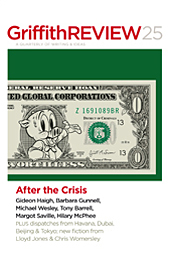Featured in

- Published 20090901
- ISBN: 9781921520761
- Extent: 264 pp
- Paperback (234 x 153mm)

Already a subscriber? Sign in here
If you are an educator or student wishing to access content for study purposes please contact us at griffithreview@griffith.edu.au
Share article
More from author

Rebel, public nuisance and dreamer
EssayFor the launch of Griffith Review 32: Wicked Problems, Exquisite Solutions, Barbara Gunnell spoke with fellow journalist Margaret Simons to outline the arguments in 'Rebel,...
More from this edition

The Ministry of Going In
PoetryThis is what happensI go insweep the floorclear the dishesinterview the Secretary of State over a flat whiteand lamingtonand ask about Afghanistan and postmodern...

A short prehistory of the future
EssayAh, the old questions, the old answers, there's nothing like them!– Samuel Beckett, Endgame Above all, the bourgeoisie produces its own gravediggers.– Karl Marx, Communist Manifesto FOR...

Who’s that dancing with my mother?
FictionWE WERE LIVING in Napier at the time. My father pulled the keys down from the hook in the kitchen and my mother asked...